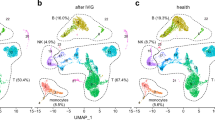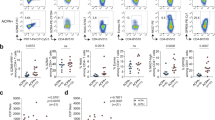Abstract
IL7 regulates T cell survival, differentiation and proliferation. The alpha chain of its receptor, CD127, is polymorphic, and its haplotypes are associated with recovery from transplantation and with the autoimmune disease multiple sclerosis (MS), especially primary progressive MS (PPMS). We demonstrate that two CD127 haplotypes are highly associated with the proportion of the mRNA encoding the soluble isoform of CD127 (P⩽0.001). The soluble isoform is over-represented (P⩽0.002) in PPMS peripheral blood, irrespective of haplotype, and the MS susceptibility haplotype produces more of the soluble isoform. CD127 mRNA is underexpressed (P⩽0.001) in PPMS. Neutrophils, which produce very low levels of CD127 mRNA, were over-represented in our PPMS cohort (P<0.02). CD127 expression is lower in more differentiated cells, such as Th1s, which can be elevated in MS. A higher proportion of these two abundant cell types in peripheral blood could be the basis for the observed reduction in CD127 mRNA. CD127 expression may be a biomarker for these potentially pathologically significant leukocyte types. These significant haplotypic effects on expression are likely to modulate regulation, differentiation and function of T cell subsets in health and disease.
This is a preview of subscription content, access via your institution
Access options
Subscribe to this journal
Receive 6 digital issues and online access to articles
$119.00 per year
only $19.83 per issue
Buy this article
- Purchase on Springer Link
- Instant access to full article PDF
Prices may be subject to local taxes which are calculated during checkout




Similar content being viewed by others
References
Kang J, Der SD . Cytokine functions in the formative stages of a lymphocyte's life. Curr Opin Immunol 2004; 16: 180–190.
Giliani S, Mori L, de Saint Basile G, Le Deist F, Rodriguez-Perez C, Forino C et al. Interleukin-7 receptor alpha (IL-7Ralpha) deficiency: cellular and molecular bases. Analysis of clinical, immunological, and molecular features in 16 novel patients. Immunol Rev 2005; 203: 110–126.
Watanabe N, Wang YH, Lee HK, Ito T, Wang YH, Cao W et al. Hassall's corpuscles instruct dendritic cells to induce CD4+CD25+ regulatory T cells in human thymus. Nature 2005; 436: 1181–1185.
Ito T, Wang YH, Duramad O, Hori T, Delespesse GJ, Watanabe N et al. TSLP-activated dendritic cells induce an inflammatory T helper type 2 cell response through OX40 ligand. J Exp Med 2005; 202: 1213–1223.
Snyder KM, Mackall CL, Fry TJ . IL-7 in allogeneic transplant: clinical promise and potential pitfalls. Leuk Lymphoma 2006; 47: 1222–1228.
Beq S, Delfraissy JF, Theze J . Interleukin-7 (IL-7): immune function, involvement in the pathogenesis of HIV infection and therapeutic potential. Eur Cytokine Netw 2004; 15: 279–289.
Haas DW, Geraghty DE, Andersen J, Mar J, Motsinger AA, D'Aquila RT et al. Immunogenetics of CD4 lymphocyte count recovery during antiretroviral therapy: an AIDS Clinical Trials Group study. J Infect Dis 2006; 194: 1098–1107.
Rosenberg SA, Sportes C, Ahmadzadeh M, Fry TJ, Ngo LT, Schwarz SL et al. IL-7 administration to humans leads to expansion of CD8+ and CD4+ cells but a relative decrease of CD4+ T-regulatory cells. J Immunother 2006; 29: 313–319.
Cox AL, Thompson SA, Jones JL, Robertson VH, Hale G, Waldmann H et al. Lymphocyte homeostasis following therapeutic lymphocyte depletion in multiple sclerosis. Eur J Immunol 2005; 35: 3332–3342.
Muraro PA, Douek DC, Packer A, Chung K, Guenaga FJ, Cassiani-Ingoni R et al. Thymic output generates a new and diverse TCR repertoire after autologous stem cell transplantation in multiple sclerosis patients. J Exp Med 2005; 201: 805–816.
Shamim Z, Ryder LP, Heilmann C, Madsen H, Lauersen H, Andersen PK et al. Genetic polymorphisms in the genes encoding human interleukin-7 receptor-alpha: prognostic significance in allogeneic stem cell transplantation. Bone Marrow Transplant 2006; 37: 485–491.
Booth DR, Arthur AT, Teutsch SM, Bye C, Rubio J, Armati PJ, et al., The Southern MS Genetics Consortium. Gene expression and genotyping studies implicate the interleukin 7 receptor in the pathogenesis of primary progressive multiple sclerosis. J Mol Med 2005; 83: 822–830.
Lundmark F, Duvefelt K, Iacobaeus E, Kockum I, Wallstrom E, Khademi M et al. Variation in interleukin 7 receptor alpha chain (IL7R) influences risk of multiple sclerosis. Nat Genet 2007; 39: 1108–1113.
Gregory SG, Schmidt S, Seth P, Oksenberg JR, Hart J, Prokop A et al. Interleukin 7 receptor alpha chain (IL7R) shows allelic and functional association with multiple sclerosis. Nat Genet 2007; 39: 1083–1091.
International Multiple Sclerosis Genetics Consortium, Hafler DA, Compston A, Sawcer S, Lander ES, Daly MJ, De Jager PL et al. Risk alleles for multiple sclerosis identified by a genomewide study. N Engl J Med 2007; 357: 851–862.
Teutsch SM, Booth DR, Bennetts BH, Heard RN, Stewart GJ . Identification of 11 novel and common single nucleotide polymorphisms in the interleukin-7 receptor-alpha gene and their associations with multiple sclerosis. Eur J Hum Genet 2003; 11: 509–515.
Robertson NP, O'Riordan JI, Chataway J, Kingsley DP, Miller DH, Clayton D et al. Offspring recurrence rates and clinical characteristics of conjugal multiple sclerosis. Lancet 1997; 349: 1587–1590.
Compston A, Sawcer S . Genetic analysis of multiple sclerosis. Curr Neurol Neurosci Rep 2002; 2: 259–266.
Sawcer S, Ban M, Maranian M, Yeo TW, Compston A, Kirby A et al. A high-density screen for linkage in multiple sclerosis. Am J Hum Genet 2005; 77: 454–467.
Frohman EM, Filippi M, Stuve O, Waxman SG, Corboy J, Phillips JT et al. Characterizing the mechanisms of progression in multiple sclerosis: evidence and new hypotheses for future directions. Arch Neurol 2005; 62: 1345–1356.
Bustin SA . Quantification of mRNA using real-time reverse transcription PCR (RT-PCR): trends and problems. J Mol Endocrinol 2002; 29: 23–39.
Abbas AR, Baldwin D, Ma Y, Ouyang W, Gurney A, Martin F et al. Immune response in silico (IRIS): immune-specific genes identified from a compendium of microarray expression data. Genes Immun 2005; 6: 319–331.
Maas K, Chan S, Parker J, Slater A, Moore J, Olsen N et al. Cutting edge: molecular portrait of human autoimmune disease. J Immunol 2002; 169: 5–9.
Strauss K, Hulstaert F, Deneys V, Mazzon AM, Hannet I, De Bruyere M et al. The immune profile of multiple sclerosis: T-lymphocyte effects predominate over all other factors in cyclophosphamide-treated patients. J Neuroimmunol 1995; 63: 133–142.
Shinar Y, Livneh A, Villa Y, Pinhasov A, Zeitoun I, Kogan A et al. Common mutations in the familial Mediterranean fever gene associate with rapid progression to disability in non-Ashkenazi Jewish multiple sclerosis patients. Genes Immun 2003; 4: 197–203.
Ben-Chetrit E, Bergmann S, Sood R . Mechanism of the anti-inflammatory effect of colchicine in rheumatic diseases: a possible new outlook through microarray analysis. Rheumatology (Oxford) 2006; 45: 274–282.
Reinhardt RL, Kang SJ, Liang HE, Locksley RM . T helper cell effector fates-who, how and where? Curr Opin Immunol 2006; 18: 271–277.
Vaknin-Dembinsky A, Balashov K, Weiner HL . IL-23 is increased in dendritic cells in multiple sclerosis and down-regulation of IL-23 by antisense oligos increases dendritic cell IL-10 production. J Immunol 2006; 176: 7768–7774.
Huang YM, Xiao BG, Ozenci V, Kouwenhoven M, Teleshova N, Fredrikson S et al. Multiple sclerosis is associated with high levels of circulating dendritic cells secreting pro-inflammatory cytokines. J Neuroimmunol 1999; 99: 82–90.
Karni A, Abraham M, Monsonego A, Cai G, Freeman GJ, Hafler D et al. Innate immunity in multiple sclerosis: myeloid dendritic cells in secondary progressive multiple sclerosis are activated and drive a proinflammatory immune response. J Immunol 2006; 177: 4196–4202.
Swainson L, Verhoeyen E, Cosset FL, Taylor N . IL-7R alpha gene expression is inversely correlated with cell cycle progression in IL-7-stimulated T lymphocytes. J Immunol 2006; 176: 6702–6708.
Poser CM, Paty DW, Scheinberg L, McDonald WI, Davis FA, Ebers GC et al. New diagnostic criteria for multiple sclerosis: guidelines for research protocols. Ann Neurol 1983; 13: 227–231.
Thompson AJ, Montalban X, Barkhof F, Brochet B, Filippi M, Miller DH et al. Diagnostic criteria for primary progressive multiple sclerosis: a position paper. Ann Neurol 2000; 47: 831–835.
Acknowledgements
This work was supported by National Health and Medical Research Council Grant 358352 and the Multiple Sclerosis Research Association, Australia. We thank the MS subjects and healthy controls for donating their blood and time, and Najwa Marmash for her excellent technical assistance.
Author information
Authors and Affiliations
Corresponding author
Rights and permissions
About this article
Cite this article
McKay, F., Swain, L., Schibeci, S. et al. Haplotypes of the interleukin 7 receptor alpha gene are correlated with altered expression in whole blood cells in multiple sclerosis. Genes Immun 9, 1–6 (2008). https://doi.org/10.1038/sj.gene.6364436
Received:
Revised:
Accepted:
Published:
Issue Date:
DOI: https://doi.org/10.1038/sj.gene.6364436
Keywords
This article is cited by
-
Targeting Homeostatic T Cell Proliferation to Control Beta-Cell Autoimmunity
Current Diabetes Reports (2016)
-
IL7R gene expression network associates with human healthy ageing
Immunity & Ageing (2015)
-
The expression of IL-7RA in Egyptian patients with multiple sclerosis
Comparative Clinical Pathology (2015)
-
The Promoter SNP, but not the Alternative Splicing SNP, is Linked to Multiple Sclerosis Among Jordanian Patients
Journal of Molecular Neuroscience (2014)
-
Interleukin-7 and Type 1 Diabetes
Current Diabetes Reports (2014)



